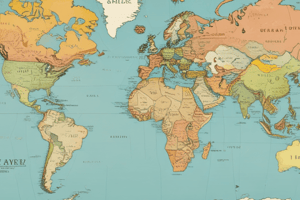Podcast
Questions and Answers
What is the primary factor that connects countries and languages throughout history?
What is the primary factor that connects countries and languages throughout history?
- Social interaction (correct)
- Geographical boundaries
- Culinary traditions
- Climate patterns
How did the Romance languages originate?
How did the Romance languages originate?
- From Arabic influences
- From Slavic origins
- From Latin (correct)
- From Germanic roots
What do linguistically-defined territories largely correspond to in modern times?
What do linguistically-defined territories largely correspond to in modern times?
- Ethnic boundaries
- Political affiliations
- Climate zones
- Countries (correct)
How does language contribute to cultural identity within countries?
How does language contribute to cultural identity within countries?
What was a significant consequence of the dialectal divergence of Romance languages?
What was a significant consequence of the dialectal divergence of Romance languages?
In what way does language help distinguish one nation from another?
In what way does language help distinguish one nation from another?
According to the passage, which of the following statements is most accurate regarding the relationship between language and cultural heritage?
According to the passage, which of the following statements is most accurate regarding the relationship between language and cultural heritage?
Which of the following is NOT mentioned as a factor influencing the linguistic demographics within countries?
Which of the following is NOT mentioned as a factor influencing the linguistic demographics within countries?
According to the passage, which of the following statements best reflects the importance of multilingual competence in global contexts?
According to the passage, which of the following statements best reflects the importance of multilingual competence in global contexts?
Based on the information provided in the passage, which of the following statements is true regarding the relationship between language and social interaction?
Based on the information provided in the passage, which of the following statements is true regarding the relationship between language and social interaction?
Which of the following statements best reflects the central idea of the passage?
Which of the following statements best reflects the central idea of the passage?
According to the passage, which of the following statements is true regarding the impact of political factors on language distribution?
According to the passage, which of the following statements is true regarding the impact of political factors on language distribution?
Flashcards are hidden until you start studying
Study Notes
Countries and Languages
Throughout history, there has been a strong connection between countries and their respective languages. This connection extends beyond mere geographical proximity and encompasses factors such as cultural identity, social interaction, and political dynamics. Let's delve into how these relationships have evolved over time and explore various aspects of this intriguing nexus.
Historical Development
The historical development of countries and languages is closely intertwined. As early civilizations emerged, they developed distinct cultures and languages that often became associated with specific territories. Over time, these linguistic and cultural patterns became increasingly linked to the geographical boundaries we recognize today as countries.
One notable example is the Romance languages, which originated from Latin and spread throughout Europe as part of the Roman Empire. Eventually, these dialects diverged into distinct languages, reflecting the political fragmentation of the empire and leading to linguistically-defined territories that correspond largely to modern-day countries.
Cultural Identity
Language plays a crucial role in shaping cultural identities within countries. It serves as a means of communication among members of a community, reinforcing shared values and traditions. Moreover, language helps define the unique character of different nations, distinguishing them from one another.
For instance, consider the vibrant literary traditions found in many countries worldwide. Works written in local languages contribute significantly to cultural heritage, fostering a sense of pride and ownership among citizens. Furthermore, international exchange programs and diplomacy often rely on proficiency in foreign languages, demonstrating the importance of linguistic diversity in global contexts.
Social Interaction
In addition to its function in conveyng cultural identity, language is essential for everyday social interaction within and among countries. Effective communication facilitates trade, diplomacy, tourism, and education exchanges. Language barriers can create misunderstandings and conflicts, highlighting the significance of multilingual competence in promoting understanding between peoples.
Moreover, recent advances in technology have enabled real-time translation services, bridging gaps in communication between speakers of different languages. This trend towards increased connectivity highlights the growing importance of mastering multiple languages in today's interconnected world.
Political Dynamics
Political factors play a significant role in determining the distribution of languages within countries. Economic stability, government policies, and migration patterns can influence linguistic demographics over time.
For example, some countries adopt official language policies aimed at promoting national unity or preserving native tongues. Others may experience linguistic shifts due to mass immigration or globalization processes, resulting in the emergence of lingua francas or regional lingolects.
Understanding these complex interactions requires careful consideration of both internal and external influences shaping the relationship between countries and their languages.
Conclusion
In summary, countries and languages share a dynamic and multifaceted relationship that shapes our global landscape. From historical development to contemporary social and political dynamics, language continues to serve as a powerful tool for expressing cultural identity, fostering cross-cultural understanding, and driving global interactions. As we move forward into an increasingly interconnected world, recognizing and respecting the diversity of human languages will remain vital for promoting peace, prosperity, and cooperation among nations.
Studying That Suits You
Use AI to generate personalized quizzes and flashcards to suit your learning preferences.




